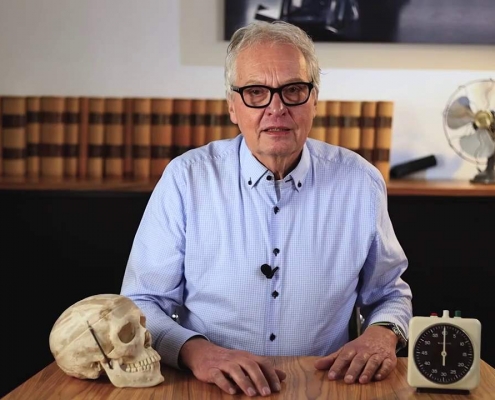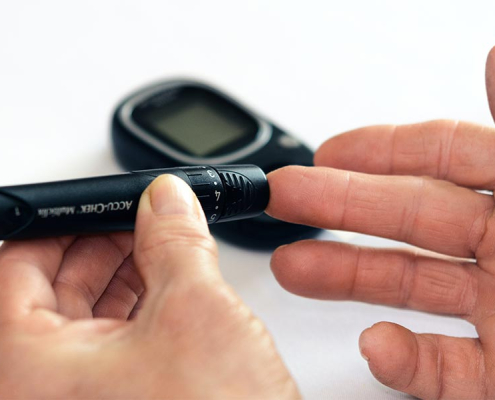Diabetic metabolism
How can FaceFormer therapy affect diabetes?en?
How can FaceFormer therapy affect diabetes?en?
A practitioner reported remarkable effects on sugar metabolism to us back in 2011. A number of his patients who trained using the FaceFormer method observed pleasing changes in their blood sugar levels.
We have many patients who we treat with the FaceFormer method. Some of them also suffer from diabetes. Diabetic patients who have used the FaceFormer therapy for completely different reasons have informed us that their blood sugar levels have reduced within a few days during the treatment. We were asked to provide an explanation. We could not spontaneously give any reasons and therefore turned to you, as you have noted diabetes on the list of indications for FaceFormer therapy. Our question is whether you are familiar with the reactions described and can explain the causal relationships.

Dr. Klaus Berndsen explains possible mechanisms of action of FaceFormer therapy in relation to diabetes.
In diabetes mellitus, the sugar that is important for cell metabolism does not reach the cells from the blood sufficiently. As a result, too much sugar remains in the blood. As a result, the cells of the muscles, liver, kidneys and fatty tissue do not have enough sugar available to produce energy. Insulin is required for the exchange of sugar between blood and body cells. The messenger substance lowers the blood sugar level by activating the cell receptors and thus stimulating the cell to absorb glucose from the blood. If this process does not take place to a sufficient extent, the blood sugar level rises. If insulin is missing, the cells cannot be supplied with sufficient sugar and break down fat. This leads to hyperacidity.
These are the differences
Proportion of the population
with diabetes mellitus
Proportion
Type 1 diabetes
Proportion
Type 2 diabetes
Common widespread disease
This metabolic disorder is also known colloquially as diabetes. The two common diabetes types 1 and 2 have different causes. Both cause elevated blood sugar levels, which greatly increase the risk of numerous secondary diseases.

Cause insulin deficiency
Type 1 diabetics usually produce little or no insulin. Due to the lack of this messenger substance, the body’s cells absorb too little glucose from the blood. Heart attacks, strokes, damage to the retina and nerves, kidney disease, periodontitis, skin disorders and even depression are among the numerous secondary diseases that can result from excess blood sugar.
The insulin deficit can be compensated for by using artificial insulin for the rest of the patient’s life.
Cause of insulin resistance
Type 2 diabetics have sufficient insulin in the early stages. However, the sensitivity of the cells to the messenger substance has decreased. As a result, the cells do not absorb enough vital sugar. The progressive insulin resistance is compensated for by an increasing output of the messenger substance. As soon as the amount of insulin produced is no longer sufficient, the familiar symptoms of diabetes mellitus appear.
Most people affected can already positively influence the process of insulin production by changing their lifestyle. A balanced diet and physical activity influence the metabolism of the whole organism.
FaceFormer method for diabetes
Regular physiological nasal breathing ensures an optimal supply of breathing air to the lungs (alveoli). In the alveoli, oxygen diffuses into the red blood cells, with which it reaches the cells. It determines the primary cell supply and the metabolism within it. Improving the metabolism within the cell optimizes overall cell activity and the absorption capacity of the sugar present in the blood.
FaceFormer therapy rhythmically stimulates those brain functions that are localised around the brain stem. All vital functions and vital organs are controlled from this region. By using FaceFormer therapy, such processes can be optimised and influence the regulation of insulin production and other metabolic processes.
Influence on the vagus nerve in the region of the mouth and throat. In addition to numerous visceral functions, the vagus nerve also controls pancreatic activity. The beta cells in the islet of Langerhans of the pancreas are responsible for this. The interactive stimulus activity on the vagus nerve in the mouth and throat region (stimulated by muscle and mucous membrane stimuli – caused by kinetic functional stimulation and negative pressure formation) could have a positive influence on visceral functions and favour insulin production.
Swallowing activity and saliva production are increased during FaceFormer training. The enzymes contained in saliva, known as amylases, are also available in greater quantities. These are significantly involved in the breakdown of polysaccharides, i.e. sugar metabolism. The enzymes can also change the formation of glucose in the small intestine in such a way that it has a positive effect on the metabolism and insulin production.
We believe that FaceFormer therapy has an impact on at least four areas that can have an effect on diabetes.
In fact, in our own practice, as well as other practitioners, we have often received similar feedback from patients who have had similar experiences. We therefore also recommend using FaceFormer therapy for diabetes as a complementary therapy to standard treatment.
The influences probably complement each other or there are others. The explanations given for the use of FaceFormer and the successes observed in the treatment of diabetes appear plausible. Nevertheless, they remain hypothetical for the time being as long as no further systematic investigation has been carried out. Monitoring the processes would be comparatively simple because diabetic patients take regular blood measurements and usually record them. Results from follow-up observations and examinations by practitioners using FaceFormer therapy could be of further help to affected patients. We look forward to every user observation and will gradually compile and analyse them.

A reduction in blood glucose levels was observed in patients who practised FaceFormer training.
You can purchase your FaceFormer online in the Dr. Berndsen Shop, from our sales partners or from numerous doctors and therapists or locally in your pharmacy.
Ask for the central pharmaceutical number PZN 18092273 (FaceFormer ONE blue).
Further product variants and useful accessories are available.
Saving tip especially for doctors and therapists: 20%++ discount on orders of 5 FaceFormers or more!
The effective solution for snoring, sleep apnea, CMD, jaw problems and many other indications. Simple, causal, effective.
Der FaceFormer ONE Der FaceFormer, ein Medizinprodukt der Klasse 1, ist aus medizinischem Elastosil gefertigt und garantiert schadstofffrei. Die Therapie zielt darauf ab, fehlerhafte Funktionsabläufe zu korrigieren, die verschiedene Symptome beeinflussen können. Seit zwei Jahrzehnten stellt die FaceFormer-Therapie eine…
Die FaceFormer® Therapie: Der FaceFormer, ein Medizinprodukt der Klasse 1, ist aus medizinischem Elastosil gefertigt und garantiert schadstofffrei. Die Therapie zielt darauf ab, fehlerhafte Funktionsabläufe zu korrigieren, die verschiedene Symptome beeinflussen können. Seit zwei Jahrzehnten stellt die FaceFormer-Therap…
Der neue FaceFormer® ZERO Auf vielfachen Anwenderwunsch hat die FaceFormer Familie Zuwachs bekommen. Zusätzlich zum bekannten FaceFormer ONE in blau oder kristallklar ist ab sofort der FaceFormer ZERO erhältlich. Was ist anders? Der FaceFormer ZERO weist eine geringere Materialhärte auf, als die bisherigen Modelle. Grö…
FaceFormer® ZERO & ONE Therapie-Set für Erwachsene Überblick: Dieses Therapie-Set umfasst die Modelle FaceFormer ZERO und FaceFormer ONE. Beide sind als medizinische Geräte der Klasse 1 aus medizinischem Elastosil® hergestellt und sind BPA-frei sowie frei von flüchtigen Stoffen. Sie sind speziell darauf ausgelegt, die …
Wasserstr.25
59423 Unna
Germany
+49 (0) 23 03-89 99 1
+49 (0) 23 03 – 89 88 6
Mo. to Fr. from 8:00 to 16:00

 Active Cosmetics by FACEFORMER Training
Active Cosmetics by FACEFORMER TrainingThis site uses cookies. By continuing to browse the site, you are agreeing to our use of cookies.
OK, agree with allAgree to essentialsShow settingsThe satisfaction of visitors to our website is important to us. In order to better address you, we use cookies. Thereby we achieve that the website works technically reliable and secure.
You can change or revoke your consent at any time.
In the privacy policy you can learn more about cookies and privacy setting.
View privacy policy
Essential cookies enable basic functionality and are necessary for the proper functioning of the website.
This data may be linked to user information of users logged in on youtube.com and google.com.
YouTube video embedding
Used to unlock YouTube content.
Google Analytics
Cookie from Google for website analytics.
Generates statistical data about how the visitor uses the website
